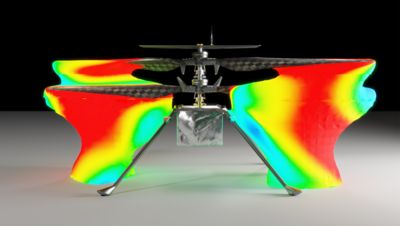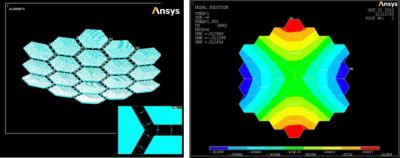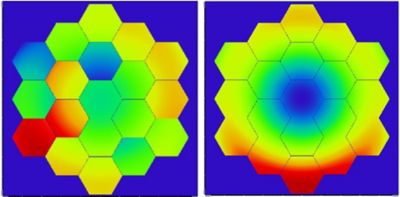-
United States -
United Kingdom -
India -
France -
Deutschland -
Italia -
日本 -
대한민국 -
中国 -
台灣
-
Ansysは、シミュレーションエンジニアリングソフトウェアを学生に無償で提供することで、未来を拓く学生たちの助けとなることを目指しています。
-
Ansysは、シミュレーションエンジニアリングソフトウェアを学生に無償で提供することで、未来を拓く学生たちの助けとなることを目指しています。
-
Ansysは、シミュレーションエンジニアリングソフトウェアを学生に無償で提供することで、未来を拓く学生たちの助けとなることを目指しています。
Ansysブログ
November 1, 2022
Ansys、C&R Technologies社のThermal Desktopの統合により、熱設計と最適化を促進
多くのエンジニアと同様に、私も物心ついたときから宇宙へのミッションに魅了されてきました。この興味は、最新の商業宇宙開発と、月に戻るというNASAの計画の再始動により、さらに高まっています。現在では、ロケットの打ち上げや宇宙の過酷な環境への対処に取り組む難しさについての知見が得られる動画や記事が溢れており、私たちが学べば学ぶほど、宇宙での成功がより印象的なものになります。
そのため、Cullimore and Ring Technologies社(以下、CRTech社)をAnsysにお迎えできることをとても嬉しく思っています。Thermal DesktopのメーカーであるCRTech社は、30年以上にわたって宇宙業界のリーダーによって使用されてきた独自の技術を多数提供しています。
想像を超えた独創性
Thermal Desktopが熱システムの設計に役立っている例は数多くあります。私が見た中で最も興味深いものの1つは、2020年の火星ミッションでPerseveranceローバーとともに打ち上げられたヘリコプター、Ingenuityです。この小型ヘリコプターの初飛行は2021年4月でした。

左上から時計回り:火星探査ヘリコプター「Ingenuity」のThermal Desktopによる熱解析。ロータの影響を強調する質量ゼロのトレーサー粒子(Ansysのシミュレーションを使用)。ロータ下の高圧ゾーン。


ご想像のとおり、非常に厳しい質量制約があるヘリコプターの電力要件を管理することは大きな課題です。火星の温度は-90°C(-130°F)まで低下するため、Ingenuityが使用する電力のほぼ半分は熱管理に使用されます。あらゆるものが正しく機能し、飛行を成功させるためには、許容飛行温度(AFT)を遵守する必要があります。こうした事項を誤って設計すると、不具合が生じ、改良や修理が不可能になります。Ingenuityは、最大5回の飛行が想定されていた技術実証としてスタートしましたが、30回以上の飛行を終えており、飛行距離と飛行期間の目標を超えています。
Thermal Desktopは、火星探査ヘリコプターやJames Webb宇宙望遠鏡のほか、より現実的なさまざまな用途で直面する難題を解決するために、世界中の熱エンジニアが使用しています。CRTech社の設計およびシミュレーションソフトウェアは、MRI装置の液体ヘリウム冷却から、ガラス製造、メタン分解炉に至るまで、あらゆる分野で利用されています。
CRTech社のチームは、熱管理、フローネットワーク、放射などの豊富な経験と専門知識を持っています。CRTech社は、顧客と緊密に協力して独自のツールを構築してきました。現在、Ansysのソリューションの一部となっているこれらのツールと、Ansysのマルチフィジックスソルバーを組み合わせて使用すれば、さらに大きな価値をもたらすことができます。



James Webb宇宙望遠鏡のさまざまな側面をシミュレーションするために、CRTech社(左)とAnsys(右)のソフトウェアが使用された。
勝利の組み合わせ
Ansys System Couplingを用いることで、Thermal Desktopは、Ansysの数値流体力学(CFD)ソリューションと連携させて解析を行うことが可能となっています。ツールのさらなる統合により、お客様はシステムレベルの熱/流体回路網と、効率的で高精度かつ詳細なシミュレーションのための完全なCFDソリューションという両方の長所を活用することができます。
Thermal Desktopには、ほぼどこからでもモデルをインポートできます。複雑な形状の場合は、Ansys SpaceClaimに組み込まれているTD Directを使用することもできます。これにより、迅速な設計反復、コンパートメントの流体体積、パイプ中心線など、さまざまな機能が利用可能となります。
複雑な形状の例としては、電気自動車のリチウムイオンバッテリモジュールなどにおいて、熱を管理する必要性が高まっていることが挙げられます。この場合は、熱シミュレーションが非常に重要になります。バッテリシステムの動作、安全性、効率は、車両走行中だけでなく、バッテリ充電中も、温度に大きく依存します。
Thermal Desktopだけでなく、TD Direct、RadCAD、FloCADの各モジュールも使用でき、これによって、モデルに取り入れる精度や詳細レベルを極めて柔軟に決定することができます。
作業は直ちに開始され、OpenTD APIを用いてThermal DesktopがAnsys ModelCenterとリンクされると、ModelCenterが提供するプロセス統合および設計最適化(PIDO: Process Integration and Design Optimization)フレームワーク内でCRTech社のツールのパラメトリック変動と外部コマンドが利用できるようになります。また、OpenTD APIは、Thermal DesktopとAnsys Systems Tool Kit(STK)を統合する際にも使用できるようになります。STKの優れたミッション計画機能とRadCADのクラス最高の放射計算機能を統合する計画が進行中です。ミッションプランナーは、月面ミッションのために月長楕円極軌道(NRHO: Near rectilinear Halo Orbits)などの複雑なミッションをRadCADに転送し、その後、Thermal Desktopの結果にアクセスしてミッションを改善することができます。
Thermal Desktopの背後にある解析エンジンがSINDA/FLUINTです。これは、二相流の特性に加え、単相から二相への遷移の複雑さにも対応し、凝縮器-蒸発器システムのほか、ヒートパイプ、二相熱サイフォンシミュレーション、低温システムおよびデュワー、ガス貯蔵および分配システム、燃料電池など、あらゆるユースケースに適用することができます。SINDA/FLUINTコードは1960年代までさかのぼる歴史を持ち、シミュレーションソフトウェアとしてのその長い歴史はAnsys Mechanical APDLよりも古いものです。
現在、AnsysとCRTech社のツール間にある相乗効果は、ほんの始まりに過ぎません。たとえば、RadCADは、窓にある物体から、船舶、航空機、宇宙船、さらには遠くの惑星に送り込まれるローバーに至るまで、あらゆるものに放射荷重を適用することができます。その後、この放射荷重は、Ansys Mechanicalでの詳細な構造応答解析や、Ansys Fluentでの完全な3次元CFDシミュレーションに活用できます。これらの荷重を用いて、光学センサーや高周波アンテナへの影響を調べることもできます。
AnsysとCRTech社のシミュレーションソリューションの組み合わせは、非常に大きな可能性を秘めています。これらのツールは、火星へのミッションから、自動運転車でミルクを買いに行くようなちょっとした用事まで、あらゆるミッションシミュレーションに対応します。










